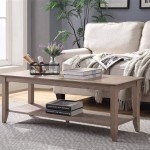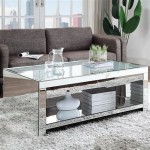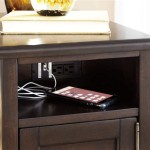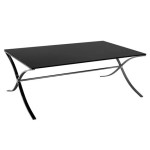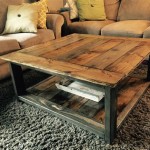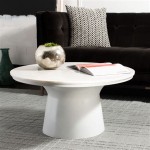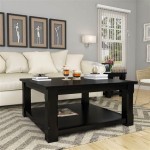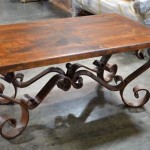How To Choose The Right Ornate Coffee Table Legs For You
Selecting the right ornate coffee table legs requires careful consideration of several factors. The legs are not merely functional supports; they contribute significantly to the overall aesthetic and style of the coffee table and the room it occupies. Matching the leg design to existing décor, considering the table's intended use, and understanding the various materials available are all vital steps in making an informed decision. This article outlines key considerations for selecting ornate coffee table legs tailored to individual needs and design preferences.
Assessing Your Interior Design Style
The prevailing interior design style of a room is the initial and arguably most important factor to assess. Ornate coffee table legs are characterized by elaborate detailing, intricate carvings, and a sense of historical or vintage aesthetics. These elements need to harmonize with the existing design themes rather than clash with them. Understanding the nuances of different styles will help in narrowing down the leg options.
For example, a room designed in a traditional style, characterized by rich colors, heavy fabrics, and classic furniture, would benefit from ornate legs with deep, elaborate carvings, perhaps finished in a dark wood stain or antique gold. Common traditional styles include Victorian, Georgian, and French Provincial. Victorian style, in particular, is known for its opulence and intricate detailing, making heavily ornamented legs a natural fit. Georgian designs lean towards symmetry and balanced proportions; therefore, ornate legs with classical motifs, such as acanthus leaves or fluted columns, would be appropriate.
Conversely, a contemporary or minimalist room, characterized by clean lines, neutral colors, and a focus on functionality, might not be the ideal environment for highly ornate legs. The stark contrast between the simple table surface and the elaborate legs could create a visual disharmony. However, if the intent is to introduce a deliberate element of contrast and texture, a carefully chosen set of ornate legs with a more streamlined design might work. In such cases, it's crucial to ensure the chosen legs have a common element with the overall design, such as a shared color palette or a subtle geometric pattern.
Rooms with an eclectic style, which combines elements from different eras and design movements, offer more flexibility. Ornate legs can be incorporated, provided they complement the existing mix of furniture and accessories. The key is to create a cohesive look by repeating certain design elements or using color to tie the different pieces together. Furthermore, the nature of the eclectic style allows for the incorporation of legs from different eras. A refurbished table with vintage legs can easily find its place in an eclectic living room.
The color palette of the room also plays a crucial role in selecting the right legs. The finish of the legs should either complement or contrast intentionally with the table top and the surrounding furniture. In a room with warm tones, legs finished in a natural wood stain or antique brass would be a good choice. In a room with cool tones, legs finished in silver, white, or a dark, cool-toned wood stain might be more suitable. It is prudent to keep the other furniture finishes in mind to create a visually appealing and well-coordinated ensemble.
Determining Size and Proportion
The size and proportion of the ornate coffee table legs must be carefully considered in relation to the overall dimensions of the coffee table top and the room itself. Legs that are too small will make the table appear unstable and visually underwhelming, whereas legs that are too large will overwhelm the table top and disrupt the balance of the room.
The height of the coffee table is typically determined by the height of the seating around it. Ideally, the coffee table should be at the same height as the seat cushions, or slightly lower. This allows for easy access to drinks and snacks without having to reach up or down excessively. Standard coffee table height ranges from 16 to 18 inches, but this can vary depending on the specific seating arrangement and personal preferences. Therefore, the height of the legs should be chosen accordingly, factoring in the thickness of the table top.
The proportion of the legs to the table top is equally important. For a large, substantial table top, thicker, more robust legs are needed to provide adequate support and visual balance. Conversely, for a smaller, more delicate table top, thinner, more refined legs would be more appropriate. As a general rule, the thickness of the legs should be proportional to the size and weight of the table top. Larger and heavier table tops require thicker and stronger legs. For ornate legs, maintaining visual balance is key. Ornate detailing can either accentuate the leg or appear too bulky. Carefully visualizing the final product can help.
The spacing between the legs is another crucial consideration. The legs should be positioned in a way that provides maximum stability and prevents the table from wobbling. The legs should be placed closer to the corners of the table top rather than clustered in the center, providing a wider base of support. The exact placement will depend on the size and shape of the table top, but the goal is to distribute the weight evenly and ensure the table is sturdy. Furthermore, the design of the leg can play a role in its placement. If the legs have intricate details that may extend outward, ensuring that there is enough space around them is also important to avoid obstructions.
The size of the room itself should also be taken into account. In a smaller room, a large, bulky coffee table with oversized legs can make the space feel cramped and cluttered. A smaller, more delicate coffee table with slender, ornate legs would be more appropriate. In a larger room, a larger coffee table with more substantial legs can anchor the space and create a focal point. Careful consideration of the room's dimensions will ensure that the coffee table is proportionate to the space and contributes to a harmonious overall design. Therefore, consider the existing furniture and its proximity. Is there enough space to move around the table comfortably?
Exploring Materials and Finishes
The material and finish of the ornate coffee table legs contribute significantly to their aesthetic appeal, durability, and longevity. Different materials offer different characteristics in terms of strength, texture, and appearance. Likewise, different finishes can enhance the beauty of the material and protect it from wear and tear.
Wood is a popular choice for ornate coffee table legs, offering a natural warmth and versatility that complements a wide range of interior design styles. Hardwoods, such as oak, maple, and walnut, are particularly well-suited for ornate legs due to their strength, durability, and ability to hold intricate carvings. Softwoods, such as pine and cedar, are less dense and easier to carve, but they are also less resistant to scratches and dents. The choice of wood will depend on the desired aesthetic, the level of detail in the carvings, and the intended use of the coffee table.
Metal is another option for ornate coffee table legs, offering a more modern and industrial aesthetic. Iron, steel, and brass are commonly used for metal legs, each offering different levels of strength, corrosion resistance, and visual appeal. Iron legs can be intricately wrought into elaborate designs, while steel legs offer a sleek, modern look. Brass legs add a touch of elegance and warmth to the coffee table, complementing both traditional and contemporary styles. Metal legs are often finished with a powder coating or plating to protect them from rust and corrosion and to enhance their aesthetic appeal.
The finish of the coffee table legs is just as important as the material. The finish can enhance the beauty of the material, protect it from wear and tear, and complement the overall design of the coffee table and the room. Common finishes for wood legs include stains, paints, and varnishes. Stains enhance the natural grain of the wood and add depth and richness to the color. Paints offer a wider range of color options and can be used to create a more contemporary or whimsical look. Varnishes provide a protective layer that seals the wood and protects it from moisture and scratches.
Metal legs are often finished with a powder coating or plating. Powder coating is a durable, scratch-resistant finish that is available in a wide range of colors. Plating involves coating the metal with a thin layer of another metal, such as chrome, nickel, or brass, to enhance its appearance and protect it from corrosion. The choice of finish will depend on the desired aesthetic, the level of durability required, and the overall design of the coffee table and the room.
When selecting the material and finish for ornate coffee table legs, it is important to consider the overall aesthetic of the room, the intended use of the coffee table, and the level of maintenance required. Wood legs may require more maintenance than metal legs, as they are more susceptible to scratches and dents. Metal legs may require periodic cleaning to prevent rust and corrosion. Careful consideration of these factors will ensure that the chosen legs are both beautiful and functional, enhancing the overall design of the coffee table and the room.

The Basics Of Coffee Table Styling Shades Blue Interiors

Coffee Table Base 106 Namu Modern Furniture Flowyline Design

Diy Farmhouse Coffee Table With Turned Legs Storage Free Plans

Diy Aged Coffee Table Grace Oaks Designs

My Favorite Flea Market Find Antique Coffee Table Bless This Nest

Metal Coffee Table Legs Flowyline Design

Types Of Table Leg Styles Complete Visual Guide Cabinfield Blog

Metal Coffee Table Legs Flowyline Design
:strip_icc()/cdn.cliqueinc.com__cache__posts__268833__how-to-choose-a-coffee-table-268833-1538077809297-image.700x0c-cf16f5357a2f470e871eb7f42afaf013.jpg?strip=all)
Don T Make This Living Room Coffee Table Mistake
:strip_icc()/cdn.cliqueinc.com__cache__posts__268833__how-to-choose-a-coffee-table-268833-1538077811019-image.700x0c-7a56fb07e0084a48b51032071b7fa87b.jpg?strip=all)
Don T Make This Living Room Coffee Table Mistake
Related Posts

